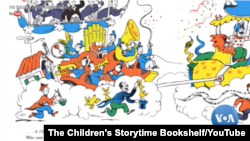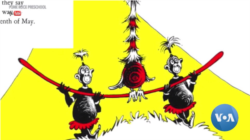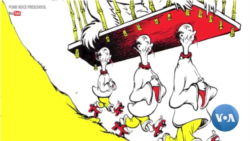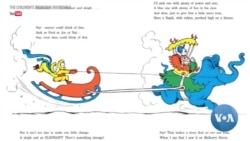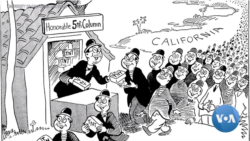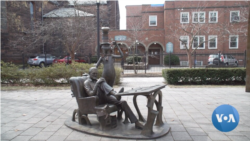Note: Due to the nature of this story, this article contains images that some might find offensive.
Critics lambasted “woke” culture earlier this month after Dr. Seuss Enterprises announced it would no longer publish six of the celebrated author’s books due to racist and insensitive imagery.
Detractors accused liberals of “canceling” the beloved children’s author who sold more than 650 million books worldwide. But it was the company founded by Dr. Seuss’s family that decided to stop printing the six books because they “portray people in ways that are hurtful and wrong.”
'Hurtful and wrong'
The offensive images in the canceled books contain disturbing racist stereotypes of Black people, Asians and Arabs.
“He often sees national or ethnic or racial difference as exotic and as fun, or as funny,” says Philip Nel, a distinguished professor of English at Kansas State University and author of “Dr. Seuss: American Icon.”
“In highlighting the exotic of somebody, or the otherness of somebody as a point of amusement, you are telling people that national or ethnic or racial difference can be the punch line, and that is painful if you are a member of the group who is the punch line.”
The canceled books include “And to Think That I Saw It on Mulberry Street”; “If I Ran the Zoo”; “McElligot’s Pool, On Beyond Zebra!”; “Scrambled Eggs Super!"; and “The Cat’s Quizzer.”
Iconic author
Dr. Seuss, whose real name was Theodor Seuss Geisel, died in 1991. During a prolific career that spanned decades and produced dozens of books, he used playful, rhythmic language, an anti-authoritarian tone, and whimsical, often outlandish, illustrations to help teach millions of children to read.
“In American children's literature, Dr. Seuss is one of the dominant figures,” says Nel, who also directs the children's literature program at Kansas State University. “It's been estimated that one out of four children receive, as its first book, a Dr. Seuss book. So, you know, he's a giant in the world of American children's literature.”
Allegations of racist stereotypes in the author’s work are not new. The Amazing World of Dr. Seuss Museum in Geisel’s hometown of Springfield, Massachusetts, removed a mural after some authors refused to visit the museum in protest. The mural depicted a Chinese character with slanted eyes, chopsticks and a pointed hat.
“The librarians have known about this for a long time and have been discussing this for decades,” says Jason Homer, executive director of the Worcester Public Library, located near the museum.
Homer says Dr. Seuss books are not particularly popular at his libraries. Only one — "The Cat in the Hat" — was among the top 100 children's titles checked out last year. Two of the banned titles have not been in circulation at the library for years, but the ones the library does own will remain on the shelves.
“Removing these books because people might object very much goes against what we stand for as a public library. We want to provide materials. Our job is to enlighten, enrich and inform our community,” Homer says. “And we can still have those informational conversations, even with these depictions that may be harmful or are harmful, to how we develop thoughts about other cultures. However, we did not remove the books.”
Political cartoons
Geisel’s racist imagery exists outside of his popular children’s books. He published political cartoons during World War II containing harmful stereotypes of Japanese Americans that questioned their patriotism.
Historian Richard Minear, author of “Dr. Seuss Goes to War,” says Geisel, who was of German ancestry, was a contradiction in that he avoided stereotyping Europeans and did promote anti-racism themes.
“He's very pro-Black-white race relations. Is very against anti-Semitism,” Minear says. “The one blind spot ... is his depictions of Japan and the Japanese. … Maybe because he had no background, his cartoons very quickly became a stereotyped Japanese figure that is offensive at best, and horribly racist at worst.”
There is evidence that Geisel eventually regretted his early depictions of non-white people. Some of his later books, such as “Horton Hears a Who!” and “The Sneeches and Other Stories” offer lessons on tolerance and inclusion.
Despite a mixed legacy, Dr. Seuss should continue to be celebrated as an artist and poet, Nel says.
“Just because someone is popular or a genius, doesn't mean that he's beyond reproach. Doesn't mean that he is also not the product of a racist society, which shaped his imagination in ways that create damage in his books and create images that damage others,” he says. “And that's OK. That's a healthy relationship to have with any art.”
There will now be fewer visits to Mulberry Street. And while it is the end of the story for these six titles, dozens of beloved Dr. Seuss books remain in print for future generations of children to discover.
“How many writers from the 1940s and ‘50s are we still reading today?” Minear says. “How could a person so right-minded on so many issues, be so bad here? In that sense, I think make it a teaching moment, rather than ‘cancel culture,’ or whatever the right phrase is.”




